《宏观经济学》课程期末试卷A卷(附参考答案)
高校宏观经济学期末考核习题及参考答案
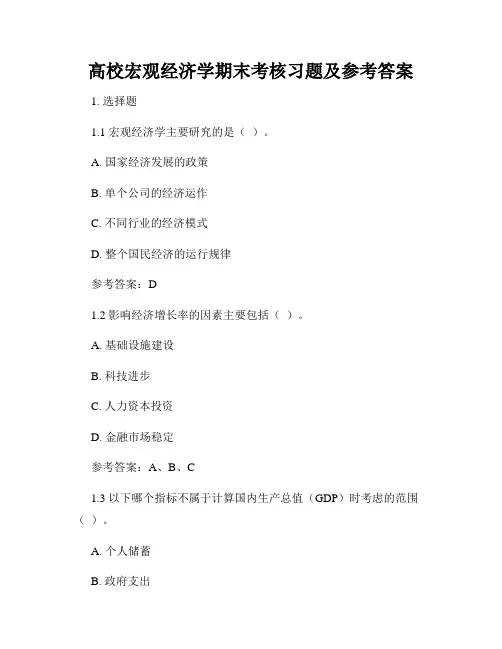
高校宏观经济学期末考核习题及参考答案1. 选择题1.1 宏观经济学主要研究的是()。
A. 国家经济发展的政策B. 单个公司的经济运作C. 不同行业的经济模式D. 整个国民经济的运行规律参考答案:D1.2 影响经济增长率的因素主要包括()。
A. 基础设施建设B. 科技进步C. 人力资本投资D. 金融市场稳定参考答案:A、B、C1.3 以下哪个指标不属于计算国内生产总值(GDP)时考虑的范围()。
A. 个人储蓄B. 政府支出C. 净出口D. 固定资本形成参考答案:A2. 简答题2.1 宏观经济学的基本概念是什么?请简要描述。
参考答案:宏观经济学是研究整个国家或地区经济体系的总体运行规律和宏观经济问题的学科。
它关注经济增长、就业、通货膨胀、货币政策等方面的问题,研究经济系统的总体运行和调控。
2.2 请简要解释什么是货币政策?参考答案:货币政策是指中央银行通过调整货币供应量和利率水平等手段来影响经济活动和价格水平的政策。
它旨在实现经济稳定和促进经济增长,通过调控货币供应和信贷规模,以及进行利率调整等策略来影响市场利率、借贷成本和金融市场活动。
3. 计算题3.1 根据以下数据,计算国家的消费水平和投资水平,并计算净出口。
消费支出:5000亿元政府支出:2000亿元投资支出:3000亿元国内生产总值(GDP):10000亿元进口:1000亿元出口:1500亿元参考答案:消费水平 = 消费支出 = 5000亿元投资水平 = 投资支出 = 3000亿元净出口 = 出口 - 进口 = 1500亿元 - 1000亿元 = 500亿元总结:本文提供了高校宏观经济学期末考核的习题及参考答案。
习题包括选择题、简答题和计算题等。
选择题涵盖了宏观经济学的基本概念和影响经济增长率的因素等内容。
简答题要求对宏观经济学和货币政策进行简要描述和解释。
计算题要求根据给定数据计算国家的消费水平、投资水平和净出口。
通过完成这些习题,学生可以巩固对宏观经济学知识的理解和运用能力,为期末考核做好准备。
宏观经济学A期末考试试题及答案
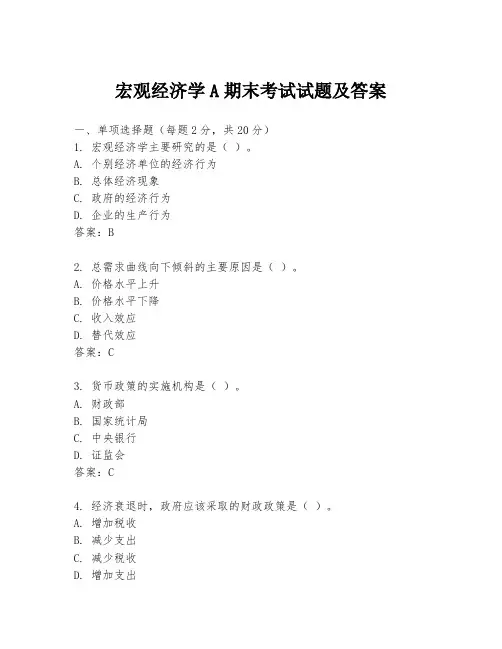
宏观经济学A期末考试试题及答案一、单项选择题(每题2分,共20分)1. 宏观经济学主要研究的是()。
A. 个别经济单位的经济行为B. 总体经济现象C. 政府的经济行为D. 企业的生产行为答案:B2. 总需求曲线向下倾斜的主要原因是()。
A. 价格水平上升B. 价格水平下降C. 收入效应D. 替代效应答案:C3. 货币政策的实施机构是()。
A. 财政部B. 国家统计局C. 中央银行D. 证监会答案:C4. 经济衰退时,政府应该采取的财政政策是()。
A. 增加税收B. 减少支出C. 减少税收D. 增加支出5. 货币供应量增加,利率下降,这表明()。
A. 货币需求减少B. 货币需求增加C. 货币供给增加D. 货币供给减少答案:C6. 通货膨胀率上升,货币的实际购买力会()。
A. 增加B. 减少C. 不变D. 不确定答案:B7. 经济中存在失业,政府应该采取的措施是()。
A. 减少公共支出B. 增加公共支出C. 增加税收D. 减少税收答案:B8. 经济增长通常与以下哪个因素有关()。
A. 资本积累B. 人口增长C. 技术进步D. 所有以上答案:D9. 长期总供给曲线是()。
B. 向上倾斜的C. 向下倾斜的D. 向右倾斜的答案:A10. 经济周期中,经济从衰退到复苏的阶段被称为()。
A. 复苏期B. 繁荣期C. 衰退期D. 萧条期答案:A二、简答题(每题10分,共40分)1. 简述凯恩斯主义经济学的主要观点。
答案:凯恩斯主义经济学认为,在短期内,总需求的变化是影响经济波动的主要因素。
政府可以通过财政政策和货币政策来调节总需求,从而实现充分就业和稳定物价。
2. 解释什么是菲利普斯曲线,并说明其在现代宏观经济学中的意义。
答案:菲利普斯曲线描述了失业率与通货膨胀率之间的负相关关系。
在短期内,较低的失业率往往伴随着较高的通货膨胀率。
然而,在长期内,这种关系可能并不稳定,因为通货膨胀预期会改变人们的行为。
3. 描述货币政策的三大工具,并简要说明它们是如何影响经济的。
宏观经济学A卷试题含答案
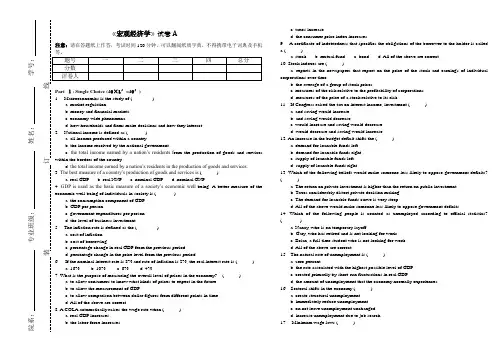
《宏观经济学》试卷A注意:请在答题纸上作答,考试时间120分钟,可以翻阅纸质字典,不得携带电子词典及手机等。
Part 1: Single Choice (40×1′=40′)1. Macroeconomics is the study of ( ) a. market regulation. b. money and financial markets. c. economy-wide phenomena. d. how households and firms make decisions and how they interact.2. National income is defined as ( ) a. all income produced within a country. b. the income received by the national government. c. the total income earned by a nation’s residents f rom the production of goods and services within the borders of the country. d. the total income earned by a nation’s residents in the production of goods and services.3. The best measure of a country’s production of goods and services is ( ) a. real GDP. b. real NNP. c. nominal GDP. d. nominal GNP.4. GDP is used as the basic measure of a society’s economic well -being. A better measure of the economic well-being of individuals in society is ( ) a. the consumption component of GDP. b. GDP per person. c. government expenditures per person. d. the level of business investment.5. The inflation rate is defined as the ( ) a. cost of inflation. b. cost of borrowing. c. percentage change in real GDP from the previous period. d. percentage change in the price level from the previous period.6. If the nominal interest rate is 8% and rate of inflation is 2%, the real interest rate is ( ) a. 16%. b. 10%. c. 6%. d. 4%.7. What is the purpose of measuring the overall level of prices in the economy? ( ) a. to allow consumers to know what kinds of prices to expect in the future b. to allow the measurement of GDP c. to allow comparison between dollar figures from different points in time d. All of the above are correct.8. A COLA automatically raises the wage rate when ( ) a. real GDP increases. b. the labor force increases.c. taxes increase.d. the consumer price index increases.9. A certificate of indebtedness that specifies the obligations of the borrower to the holder is called a ( ) a. stock. b. mutual fund. c. bond. d. All of the above are correct. 10. Stock indexes are ( ) a. reports in the newspapers that report on the price of the stock and earnings of individual corporations over time. b. the average of a group of stock prices. c. measures of the risk relative to the profitability of corporations. d. measures of the price of a stock relative to its risk.11. If Congress raised the tax on interest income, investment ( ) a. and saving would increase. b. and saving would decrease. c. would increase and saving would decrease. d. would decrease and saving would increase. 12. An increase in the budget deficit shifts the ( ) a. demand for loanable funds left. b. demand for loanable funds right. c. supply of loanable funds left. d. supply of loanable funds right.13. Which of the following beliefs would make someone less likely to oppose government deficits? ( ) a. The return on private investment is higher than the return on public investment. b. Taxes considerably distort private decision making. c. The demand for loanable funds curve is very steep. d. All of the above would make someone less likely to oppose government deficits.14. Which of the following people is counted as unemployed according to official statistics? ( ) a. Nancy, who is on temporary layoff b. Gary, who has retired and is not looking for work c. Brian, a full-time student who is not looking for work d. All of the above are correct.15. The natural rate of unemployment is ( ) a. zero percent. b. the rate associated with the highest possible level of GDP. c. created primarily by short-run fluctuations in real GDP. d. the amount of unemployment that the economy normally experiences. 16. Sectoral shifts in the economy ( ) a. create structural unemployment. b. immediately reduce unemployment. c. on net leave unemployment unchanged. d. increase unemployment due to job search. 17. Minimum wage laws ( )院系: 专业班级: 姓名: 学号:装 订 线a. probably reduce teenage employment.b. are probably the major cause of natural unemployment.c. probably most adversely affect skilled workers.d. All of the above are correct.18. Angela is the newly appointed CEO of a company that manufactures computer chips on an assembly line. Her staff has told her that given productivity numbers, they suspect some workers may be shirking. According to efficiency wage theory, what should she do? ( ) a. Pay all workers more than the equilibrium wage rate. b. Reward those who shirk with higher wages. c. Pay below the equilibrium wage rate to make up for the loss from shirking. d. Make sure that workers are getting paid exactly the equilibrium wage rate.19. Which of the following best illustrates the unit of account function of money? ( ) a. You list prices for candy sold on your Web site, , in dollars. b. You pay for tickets to a WNBA game with dollars. c. You keep $10 in your backpack for emergencies. d. None of the above is correct. 20. M1 includes ( ) a. savings deposits. b. money market deposit accounts. c. currency. d. All of the above are correct.21. The Federal Open-market Committee is made up of ( ) a. 5 of the 12 presidents of the Federal Reserve Regional banks, and the 7 members of the Board of Governors. b. the 12 presidents of the Federal Reserve Regional banks, and the Chair of the Board of Governors. c. the 12 presidents of the Federal Reserve Regional banks, and the 7 members of the Board of Governors. d. 7 of the 12 presidents of the Federal Reserve Regional banks, and the 5 members of the Board of Governors.22. If banks choose to hold more excess reserves, ( ) a. required reserves in the banking system increase. b. the money multiplier will increase. c. the discount rate will increase. d. the money supply falls.23. The Fed can influence unemployment in ( ) a. the short run, but not the long run. b. the short and long run. c. the long run, but not the short run. d. neither the short nor long run.24. When the price level rises, the number of dollars needed to buy a representative basket of goods ( ) a. decreases, so the value of money rises. b. decreases, so the value of money falls. c. increases, so the value of money rises.d. increases, so the value of money falls.25. If velocity and output were nearly constant, ( ) a. the inflation rate would be much higher than the money supply growth rate. b. the inflation rate would be much lower than the money supply growth rate. c. the inflation rate would be about the same as the money supply growth rate. d. Any of the above could be correct, more information is needed.26. If the money supply growth rate permanently increased from 10 percent to 20 percent we would expect that inflation and nominal interest rates would both increase ( ) a. by more than 10 percentage points. b. by 10 percentage points. c. but by less than 10 percentage points. d. None of the above is correct. 27. Shoeleather costs refer to ( ) a. the cost of more frequent price changes induced by higher inflation. b. resources used to maintain lower money holdings when inflation is high. c. the distortion in resource allocation created by distortions in relative prices due to inflation. d. the distortion in incentives, created by inflation, by taxes that do not adjust for inflation. 28. In order to maintain stable prices, the central bank must ( ) a. tightly control the money supply. b. keep unemployment low. c. sell indexed bonds. d. All of the above are correct. 29. Business cycles ( ) a. are explained mostly by fluctuations in corporate profits. b. no longer are very important due to government policy. c. are fluctuations in real GDP and related variables over time. d. All of the above are correct.30. Most economists believe that classical economic theory is a good description of the world in ( ) a. the long run, but not in the short run. b. the short run, but not in the long run. c. the short run and in the long run. d. neither the short nor long run.31. A decrease in U.S. interest rates leads to ( ) a. an appreciation of the dollar that leads to smaller exports. b. an appreciation of the dollar that leads to greater net exports. c. a depreciation of the dollar that leads to smaller net exports. d. a depreciation of the dollar that leads to greater net exports. 32. The long-run aggregate supply curve shifts right if ( ) a. Congress raises the minimum wage substantially. b. unemployment insurance benefits are made more generous. c. immigration from abroad increases. d. All of the above are correct.院系: 专业班级: 姓名: 学号:装 订 线33. Suppose a shift in aggregate demand creates an economic contraction. If policymakers can respond with sufficient speed and precision, they can offset the initial shift by shifting aggregate ( ) a. supply left. b. supply right. c. demand left. d. demand right.34. Which of the following has been suggested as an important cause of the Great Depression? ( ) a. a decline in the money supply b. a large decline in government expenditures c. an increase in the relative price of oil d. All of the above are correct.35. According to liquidity preference theory, which of the following shifts the money demand curve to the left? ( ) a. a decrease in the price level b. an increase in the price level c. an increase in the interest rate d. Both b and c are correct.36. If Congress cuts spending to balance the federal budget, the Fed can act to prevent unemployment and recession while maintaining the balanced budget by ( ) a. raising taxes. b. cutting expenditures. c. increasing the money supply. d. decreasing the money supply.37. Investment tax credits are designed to ( ) a. increase aggregate demand in the short run and eventually increase long-run aggregate supply. b. increase aggregate demand in the short run, but eventually decrease long-run aggregate supply. c. increase aggregate demand in the short run and have no impact on aggregate supply. d. None of the above is correct.38. According to Friedman and Phelps, the unemployment rate is above the natural rate when actual inflation ( ) a. is greater than expected inflation. b. equals expected inflation. c. is less than expected inflation. d. is high.39. The restrictive monetary policy followed by the Fed in the early 1980s ( ) a. reduced both unemployment and inflation. b. reduced inflation significantly, but at the cost of a severe recession. c. reduced unemployment significantly, but at the cost of higher inflation. d. raised both unemployment and inflation.40. A favorable supply shock will cause the short-run Phillips curve to shift ( ) a. left, and unemployment to rise. b. left, and unemployment to fall. c. right, and unemployment to rise. d. right, and unemployment to fall.Part 2: Simply answer following questions (4×5′=20′)1. How will following events influence the GDP of U.S. by expenditure method? (1)Boeing Company sold a plane to the U.S. Air Force. (2)Boeing Company sold a plane to the U.S. Air Company. (3)Boeing Company sold a plane to the Franc Air Company. (4)Boeing Company sold a plane to Mr. Cross.(5)Boeing Company produced a plane which will be sold in the next half year. 2. Who control the money supply? How does it control?3. Try to tell the relationship between short run Philips curve and long run Philips curve.4. What factors can cause unemployment? How?Part3: Calculate (2×10′=20′)1. Consider following events in certain economy:Y=5000、G=1000、T=1000、C=250+0.75(Y -T)、I=1000+50R(1)Try to calculate private saving, public saving and national saving in this economy (2) Try to find the equilibrium interest rate(3) Suppose Government purchase increase to 1250, try to calculate private saving, public saving and national saving(4) Try to find the new equilibrium2. Suppose in an economy, there are 0.76 billion adults, and 0.48 billion of them are working, 0.04 billion of them are looking for job, 0.18 billion of them are neither working nor looking for a job. Try to calculate(1) Labor force amount (2) Labor participate rate (3) Unemployment ratePart4: Analysis following questions(2×10′=20′)1. Try to tell the development path of macroeconomics. (How did it appear? How did it change?)2. Try to use the macroeconomics knowledge to analyze the current economic condition and try toafford some macroeconomic policies in China, and try to analyze their impacts to economy.院系: 专业班级: 姓名: 学号:装 订 线《国际贸易专业宏观经济学》试卷A宏观经济学(双语)A 卷参考答案Part1:1C 2D 3A 4B 5D 6C 7C 8D 9C 10B 11 B 12C 13C 14A 15D 16D 17A 18A 19A 20C 21A 22D 23A 24D 25C 26B 27B 28A 29C 30A 31A 32C 33D 34A 35A 36C 37A 38C 39B 40B Part2:1. (1) Increases government purchases and then increases GDP (2) Increases investment and then increases GDP (3) Increases net export and then increases GDP (4) Increases consumption and then increase GDP (5) Increases investment and then increase GDP2. Federal Open Market Committee conducts monetary policy by controlling the money supply. The money supply is the quantity of money available in the economy. The primary way in which the Fed changes the money supply is through open-market operations. The Fed purchases and sells U.S. government bonds. To increase the money supply, the Fed buys government bonds from the public. To decrease the money supply, the Fed sells government bonds to the public.3. The Phillips curve shows the short-run combinations of unemployment and inflation that arise as shifts in the aggregate demand curve move the economy along the short-run aggregate supply curve. The Phillips curve seems to offer policymakers a menu of possible inflation and unemployment outcomes. As a result, the long-run Phillips curve is vertical at the natural rate of unemployment. Monetary policy could be effective in the short run but not in the long run. In the long run, expected inflation adjusts to changes in actual inflation.4. Job search, this unemployment is different from the other types of unemployment. It is not caused by a wage rate higher than equilibrium. It is caused by the time spent searching for the “right” job. Minimum wage laws, although minimum wages are not the predominant reason for unemployment in our economy, they have an important effect on certain groups with particularly high unemployment rates. When the minimum wage is set above the level that balances supply and demand, it creates unemployment. Unions, a union is a worker association that bargains with employers over wages and working conditions. In the 1940s and 1950s, when unions were at their peak, about a third of the U.S. labor force was unionized. A union is a type of cartel attempting to exert its market power. Efficiency wages, Efficiency wages are above-equilibrium wages paid by firms in order to increase worker productivity. The theory of efficiency wages states that firms operate more efficiently if wages are above the equilibrium level.Part3:1. (1) Private saving=Y-T-C=5000-1000-(250+0.75*4000)=750 Public saving=T-G=1000-1000=0 National saving=750(2) I=S 1000+50R=750 R=-5 (3) Private saving=750Public saving=T-G-1000-1250=-250 National saving=500(4) 1000+50R=500 R=-10 2. (1) labor force: 0.48+0.04=0.52(2) Labor participate rate: 0.52/0.76=68% (3) Unemployment rate: 0.04/0.52=7.7%院系: 专业班级: 姓名: 学号:装 订 线。
09-10宏观A卷有完整答案
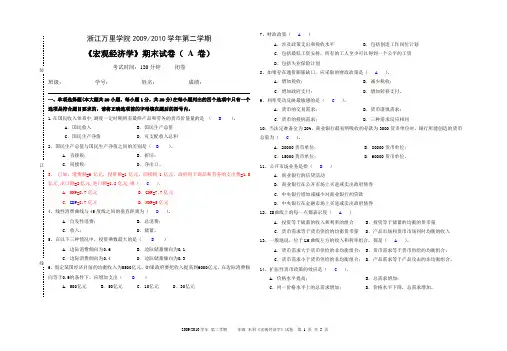
浙江万里学院2009/2010学年第二学期《宏观经济学》期末试卷( A 卷)考试时间:120分钟闭卷班级:学号:姓名:成绩:一、单项选择题(本大题共20小题,每小题1分,共20分)在每小题列出的四个选项中只有一个选项是符合题目要求的,请将正确选项前的字母填在题后的括号内。
1.在国民收入体系中,测度一定时期所有最终产品和劳务的货币价值量的是( B)。
A.国民收入 B.国民生产总值C.国民生产净值 D.可支配收入总和2、国民生产总值与国民生产净值之间的差别是( B)。
A.直接税; B.折旧;C.间接税; D.净出口。
3、已知:消费额=6亿元,投资额=1亿元,间接税1亿元,政府用于商品和劳务的支出费=1.5亿元,出口额=2亿元,进口额=1.8亿元,则(C)。
A.NNP=8.7亿元 B.GNP=7.7亿元C.GDP=8.7亿元 D.NNP=5亿元4、线性消费曲线与45度线之间的垂直距离为( D )。
A.自发性消费; B.总消费;C.收入; D.储蓄。
5、在以下三种情况中,投资乘数最大的是( B )A.边际消费倾向为0.6 B.边际储蓄倾向为0.1C.边际消费倾向为0.4 D.边际储蓄倾向为0.36、假定某国经济目前的均衡收入为5500亿元,如果政府要把收入提高到6000亿元,在边际消费倾向等于0.9的条件下,应增加支出( B )A.500亿元 B.50亿元 C.10亿元 D.30亿元7、财政政策(A)A.涉及政策支出和税收水平 B.包括创造工作岗位计划C.包括最低工资安排,所有的工人至少可以得到一个公平的工资D.包括失业保险计划8、如果存在通货膨胀缺口,应采取的财政政策是(A)。
A.增加税收; B.减少税收;C.增加政府支付; D.增加转移支付。
9、利率变动反映最敏感的是(C)。
A.货币的交易需求; B.货币谨慎需求;C.货币的投机需求; D.三种需求反应相同10、当法定准备金为20%,商业银行最初所吸收的存款为3000货币单位时,银行所能创造的货币总量为(C)。
宏观经济学试卷库(附答案)
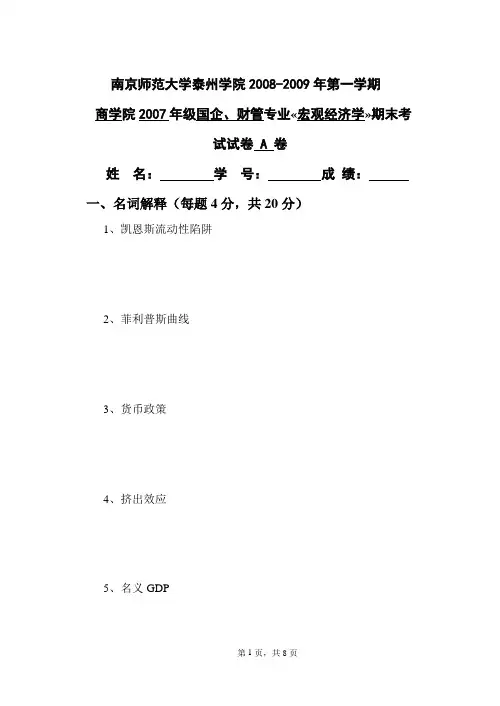
南京师范大学泰州学院2008-2009年第一学期商学院2007年级国企、财管专业«宏观经济学»期末考试试卷 A 卷姓名:学号:成绩:一、名词解释(每题4分,共20分)1、凯恩斯流动性陷阱2、菲利普斯曲线3、货币政策4、挤出效应5、名义GDP二、单项选择题(每题1分,共20分)1、在四部门经济中,GDP是指()的总和。
A.消费、净投资、政府购买和净出口B.消费、总投资、政府购买和净出口C.消费、总投资、政府购买和总出口D.消费、净投资、政府购买和总出口2、关于投资与利率的关系,以下判断正确的是()。
A.投资是利率的增函数B.投资是利率的减函数C.投资与利率是非相关关系D.以上判断都不正确3、IS曲线与LM曲线相交时表示()。
A.产品市场处于均衡状态,而货币市场处于非均衡状态B.产品市场处于非均衡状态,而货币市场处于均衡状态C.产品市场与货币市场都处于均衡状态D.产品市场与货币市场都处于非均衡状态4、抑制需求拉上的通货膨胀,应该()。
A.降低工资B.减税C.控制货币供给量D解除托拉斯组织5、在其他条件不变的情况下,政府购买增加会使IS曲线()。
A.向左移动B.向右移动C.保持不变D.发生转动6、一国贸易盈余表示该国()。
A.消费超过产出并且净出口盈余B.消费超过产出并且净出口赤字C.消费低于产出并且净出口盈余D.消费低于产出并且净出口赤字7、在两部门经济模型中,如果边际消费倾向值为0.8,那么自发支出乘数值应该是()。
A.4B.2.5C.5D.1.68、如果中央银行采取扩张性的货币政策,可以()。
A.在公开市场买入债券,以减少商业银行的准备金,促使利率上升B.在公开市场卖出债券,以增加商业银行的准备金,促使利率下跌C.在公开市场买入债券,以增加商业银行的准备金,促使利率下跌D.在公开市场卖出债券,以减少商业银行的准备金,促使利率上升9、已知,C=3000亿元,I=800亿元,G=960亿元,X=200亿元,M=160亿元,折旧=400亿元,则()不正确。
宏观经济学试卷A及答案
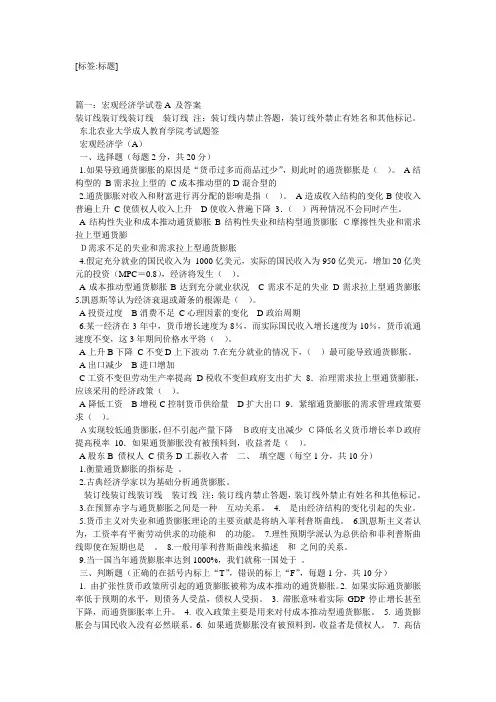
[标签:标题]篇一:宏观经济学试卷A 及答案装订线装订线装订线装订线注:装订线内禁止答题,装订线外禁止有姓名和其他标记。
东北农业大学成人教育学院考试题签宏观经济学(A)一、选择题(每题2分,共20分)1.如果导致通货膨胀的原因是“货币过多而商品过少”,则此时的通货膨胀是()。
A结构型的B需求拉上型的C成本推动型的D混合型的2.通货膨胀对收入和财富进行再分配的影响是指()。
A造成收入结构的变化B使收入普遍上升C使债权人收入上升D使收入普遍下降3.()两种情况不会同时产生。
A结构性失业和成本推动通货膨胀B结构性失业和结构型通货膨胀C摩擦性失业和需求拉上型通货膨D需求不足的失业和需求拉上型通货膨胀4.假定充分就业的国民收入为1000亿美元,实际的国民收入为950亿美元,增加20亿美元的投资(MPC=0.8),经济将发生()。
A成本推动型通货膨胀B达到充分就业状况C需求不足的失业D需求拉上型通货膨胀5.凯恩斯等认为经济衰退或萧条的根源是()。
A投资过度B消费不足C心理因素的变化D政治周期6.某一经济在3年中,货币增长速度为8%,而实际国民收入增长速度为10%,货币流通速度不变,这3年期间价格水平将()。
A上升B下降C不变D上下波动7.在充分就业的情况下,()最可能导致通货膨胀。
A出口减少B进口增加C工资不变但劳动生产率提高D税收不变但政府支出扩大8.治理需求拉上型通货膨胀,应该采用的经济政策()。
A降低工资B增税C控制货币供给量D扩大出口9.紧缩通货膨胀的需求管理政策要求()。
A实现较低通货膨胀,但不引起产量下降B政府支出减少C降低名义货币增长率D政府提高税率10.如果通货膨胀没有被预料到,收益者是()。
A股东B 债权人C债务D工薪收入者二、填空题(每空1分,共10分)1.衡量通货膨胀的指标是。
2.古典经济学家以为基础分析通货膨胀。
装订线装订线装订线装订线注:装订线内禁止答题,装订线外禁止有姓名和其他标记。
宏观经济学期末考试试题(含答案)
《宏观经济学》期末考试试题一、判断题(对的写“T”,错的写“F”;每小题1分,共10分)1.人均真实GDP是平均经济福利(生活水平)的主要衡量指标。
2.1963年美国的最低工资水平是每小时1.25美元,而2013年则为7.25美元,因而,在美国拿最低工资的人的生活水平大大提高了。
3.大多数失业是短期的,然而,大多数所观察到的失业是长期的。
4.通货膨胀并没有降低大多数工人的购买力。
5.家庭决定把大部分收入储蓄起来会使总供给曲线向左移动。
6.某人出售一幅旧油画所得到的收入应该计入当年的国内生产总值。
7.无论什么人,只要没有找到工作就是失业。
8.短期总供给不变时,总需求的变动会引起均衡的国内生产总值同方向变动,物价水平反方向变动。
9.扩张性货币政策的实行可以增加货币供给量,从而使利率水平提高。
10.总需求不足时,政府可以提高转移支付水平,以增加社会总需求。
二、简答题(每小题5分,共15分)1.列出并说明生产率的四个决定因素。
2.解释企业通过提高它所支付的工资增加利润的四种可能原因。
3.是什么因素可能引起总需求曲线向左移动?三、应用题(每小题5分,共20分)假设今年的货币供给是5 00亿美元,名义GDP是10万亿美元,而真实GDP是5万亿美元。
1.物价水平是多少?货币流通速度是多少?2.假设货币流通速度是不变的,而每年经济中物品与服务的产出增加5%。
如果美联储保持货币供给不变,明年的名义GDP和物价水平是多少?3.如果美联储想保持物价水平不变,它应该把明年的货币供给设定为多少?4.如果美联储想把通货膨胀率控制在10%,它应该把货币供给设定为多少?四、计算与分析说明题(每小题10分,共30分;要有计算步骤,否则扣分)b.把2015年作为基年,计算各年的真实GDP。
c.与2016年相比,2017年的名义GDP、真实GDP增长率各是多少?名义GDP增长率和真实GDP增长率孰大孰小?解释原因。
2.一个经济在产出低于其自然水平4000亿美元的水平上运行,而且财政政策制定者想弥补这种衰退性缺口。
宏观经济学期末考试试卷1(附答案)
一、选择题 (每小题 1 分,共 30 分)1.The government reports that "GDP increased by 1.6 percent in the last quarter." This statement means that GDP increaseda. by 6.4 percent for the year.b. at an annual rate of 6.4 percent during the last quarter.c. at an annual rate of 1.6 percent during the last quarter.d. at an annual rate of .4 percent during the last quarter.2.A Brazilian company produces soccer balls in the United States and exports all of them. If the price of the soccer balls increases, the GDP deflatora. and the CPI both increase.b. is unchanged and the CPI increases.c. increases and the CPI is unchanged.d. and the CPI are unchanged.3.The price of CD players increases dramatically, causing a 1 percent increase in the CPI. The price increase will most likely cause the GDP deflator to increase bya. more than 1 percent.b. less than 1 percent.c. 1 percent.d. It is impossible to make an informed guess without more information.4.A nation's standard of living is measured by itsa. real GDP.b. real GDP per person.c. nominal GDP.d. nominal GDP per person.5.In 2002 President Bush imposed restrictions on imports of steel to protect the U.S.steel industry.a. This is an inward-oriented policy which most economists believe have adverseeffects on growth.b. This is an inward-oriented policy which most economists believe have beneficial effects ongrowth.c. This is an outward-oriented policy which most economists believe have adverse effects on growth.d. This is an outward-oriented policy which most economists believe have beneficial effects ongrowth.6.Generally when economists and the text talk of the "interest rate," they are talking about thea. real interest rate.b. current nominal interest rate.c. real interest rate minus the inflation rate.d. equilibrium nominal interest rate.7.An increase in the budget deficita. makes investment spending fall.b. makes investment spending rise.c. does not affect investment spending.d. may increase, decrease, or not affect investment spending.8.Norne Corporation is considering building a new plant. It will cost them $1 million today to build it and it will generate revenues of $1,121 million three years from today. Of the interest rates below, which is the highest interest rate at which Norne would still be willing to build the plant?a. 3 percentb. 3.5 percentc. 4 percentd. 4.5 percent9.Recent entrants into the labor force account for abouta. 1/2 of those who are unemployed. Spells of unemployment end about 1/5 of the time with peopleleaving the labor force.b. 1/3 of those who are unemployed. Spells of unemployment end about 1/2 of the time with peopleleaving the labor force.c. 1/4 of those who are unemployed. Spells of unemployment end about 1/2 of the time with peopleleaving the labor force.d. 1/4 of those who are unemployed. Spells of unemployment end about 1/5 of the time with peopleleaving the labor force10.Which of the following best illustrates the unit of account function of money?a. You list prices for candy sold on your Web site, , indollars.b. You pay for your WNBA tickets with dollars.c. You keep $10 in your backpack for emergencies.d. None of the above is correct.11.Current U.S. currency isa. fiat money with intrinsic value.b. fiat money with no intrinsic value.c. commodity money with intrinsic value.d. commodity money with no intrinsic value.12.Velocity in the country of Shem is always stable. In 2002, the money supply was $200 billion and the GDP price deflator was four times as high as it was in the base year. In 2003, the money supply increased to $240 billion, the price level increased by 15 percent, and nominal GDP equaled $1,200 billion. By how much did real GDP increase between 2002 and 2003?a. 20 percentb. 4.35 percentc. 2.17 percentd. There is not enough information to answer the question.13.Shoeleather costs refer toa. the cost of more frequent price changes induced by higher inflation.b. the distortion in resource allocation created by distortions in relative prices dueto inflation.c. resources used to maintain lower money holdings when inflation is high.d. the distortion in incentives created by inflation by taxes that do not adjust forinflation.14.International tradea. raises the standard of living in all trading countries.b. lowers the standard of living in all trading countries.c. leaves the standard of living unchanged.d. raises the standard of living for importing countries and lowers it for exporting countries.15.Which of the following would be U.S. foreign portfolio investment?a. Disney builds a new amusement park near Rome, Italy.b. Your economics professor buys stock in companies located in Eastern European countries.c. A Dutch hotel chain opens a new hotel in the United States.d. A citizen of Singapore buys a bond issued by a U.S. corporation.16.A Venezuelan firm purchases earth-moving equipment from a U.S. company and pays for it with domestic currency. This transactiona. increases U.S. net exports, and increases Venezuelan net capital outflow.b. increases U.S. net exports, and decreases Venezuelan net capital outflow.c. decreases U.S. net exports, and increases Venezuelan net capital outflow.d. decreases U.S. net exports, and decreases Venezuelan net capital outflow.17.At the equilibrium interest rate in the open economy macroeconomic model, the amount that people want to save equals the desired quantity ofa. net capital outflow.b. domestic investment.c. net capital outflow plus domestic investment.d. foreign currency supplied.18.In an open economy,a. net capital outflow = imports.b. net capital outflow = net exports.c. net capital outflow = exports.d. None of the above is correct.19.In the open-economy macroeconomic model, the real exchange rate is determined in the market where dollars are exchanged for foreign currency by the equality of the supply of dollars, which comes froma. U.S. national saving and the demand for dollars for U.S. net exports.b. U.S. net capital outflow and the demand for dollars for U.S. net exports.c. domestic investment and the demand for U.S. net exports.d. foreign demand for U.S. goods and U.S. demand for foreign goods.20.If a government increases its budget deficit, then interest ratesa. rise and the trade balance moves toward surplus.b. rise and the trade balance moves toward deficit.c. fall and the trade balance moves toward surplus.d. fall and the trade balance moves toward deficit.21.Investment spending decreases when the price levela. rises causing interest rates to rise.b. rises causing interest rates to fall.c. falls causing interest rates to rise.d. falls causing interest rates to fall.22.An increase in the price level and a decrease in real GDP in the short run could be created bya. an increase in the money supply.b. an increase in government expenditures.c. a fall in stock prices.d. bad weather in farm states.23.Which part of real GDP fluctuates most over the course of the business cycle?a. consumptionb. government expendituresc. investmentd. net exports24.According to liquidity preference theory, the price level and interest rate area. positively related as are the interest rate and aggregate demand.b. inversely related as are the interest rate and aggregate demand.c. positively related while the interest rate and aggregate demand are inverselyrelated.d. inversely related while the interest rate and aggregate demand are positivelyrelated.25.Which of the following shifts aggregate demand to the right?a. an increase in the price levelb. an increase in the money supplyc. a decrease in the price leveld. a decrease in the money supply26.If the Fed conducts open-market sales, the money supplya. increases and aggregate demand shifts right.b. increases and aggregate demand shifts left.c. decreases and aggregate demand shifts right.d. decreases and aggregate demand shifts left.27.Some economists argue thata. monetary policy should actively be used to stabilize the economy.b. fiscal policy should actively be used to stabilize the economy.c. fiscal policy can be used to shift the AD curve.d. All of the above are correct.28.The lag problem associated with monetary policy is due mostly toa. the fact that business firms make investment plans far in advance.b. the political system of checks and balances that slows down the process of determining monetarypolicy.c. the time it takes for changes in government spending to affect the interest rate.d. All of the above are correct.29.A. W. Phillips' findings were based on dataa. from 1861-1957 for the United Kingdom.b. from 1861-1957 for the United States.c. mostly from the post-World War II period in the United Kingdom.d. mostly from the post-World War II period in the United States.30.Which of the following is true concerning the long-run Phillips curve?a. Its position is determined primarily by monetary factors.b. If it shifts right, long-run aggregate supply shifts right.c. It cannot be changed by any government policy.d. its position depends on the natural rate of unemployment.二、判断题(每小题 1 分,共 20 分)31.The government component of GDP includes salaries paid to Army generals but not Social Security benefits to the elderly.32.An increase in the saving rate does not permanently increases the growth rate of real GDP per person.33.In ten years when you are the owner of a major U.S. corporation, if your corporation opens and operates a branch in a foreign country you will be engaging in foreign direct investment.34.Corporations receive no proceeds from the resale of their stock.35.According to the rule of 70, if you earn an interest rate of 3.5 percent, your savings will double about every 20 years.36.The value of a stock depends on the ability of the company to generate dividends and the expected price of the stock when the stockholder sells her shares.37.A minimum wage above equilibrium creates a labor surplus.38.According to the theory of efficiency wages, firms operate more efficiently if they can pay wages that are below the equilibrium level. 39.The use of money allows trade to be roundabout.40.The quantity theory of money can explain hyperinflations but not moderate inflation.41.In every economy, national saving equals domestic investment plus net capitaloutflow.42.In the open-economy macroeconomic model, net exports represent the quantity of dollars demanded in the foreign-currency exchange market.43.Although trade policies do not affect a country's overall trade balance, they do affectspecific firms and industries.44.If speculators bid up the value of the dollar in the market for foreign-currency exchange, aggregate demand would shift to the left.45.In response to a decrease in output the economy would revert to its original level of prices and output whether the decrease in output was caused by a decrease in aggregate demand or a decrease in aggregate supply.46.John Maynard Keynes advocated policies that would increase aggregate demand as a way to decrease unemployment caused by recessions.47.An increase in the money supply shifts the aggregate supply curve right. 48.Unemployment insurance and welfare programs work as automatic stabilizers. 49.In the long run, the inflation rate depends primarily on money supply growth.50.Although monetary policy cannot reduce the natural rate of unemployment, other types of policies can. 三、名词解释(每小题 2分,共 10 分)51.catch-up effect: 52.depreciation: 53.capital flight: 54.recession:55.automatic stabilizers: 四、简答题( 8题中任选6题;每小题 5分,共 30 分)56.Compare and contrast the population theories of Malthus and Kremer.57.Using a graph representing the market for loanable funds, show and explain what happens to interest rates and investment if a government goes from a deficit to a surplus.58.Which two of the Ten Principles of Economics imply that the Fed can profoundly affect the economy?59.The U.S. Treasury Department issues inflation-indexed bonds. What areinflation-indexed bonds and why are they important?60.Make a list of things that would shift the long-run aggregate supply curve to the right.61.Illustrate the classical analysis of growth and inflation with aggregate demand and long-run aggregate supply curves.62.How does a reduction in the money supply by the Fed make owning stocks less attractive?63.Why and in what way are fiscal policy lags different from monetary policy lags?五、讨论题(2题中任选1题;每小题 10 分,共 10分)64. Suppose government spends $3 billion to buy police cars. Explain why aggregate demand might increase by more than $3 billion. Explain why aggregate demand might increase by less than $3 billion.65. In 1939, with the U.S. economy not yet fully recovered from the Great Depression, President Roosevelt proclaimed that Thanksgiving would fall a week earlier than usual so that the shopping period before Christmas would be longer. Explain this decision, using the model of aggregate demand and aggregate supply.《宏观经济学》答题纸一、选择题 (每小题 1 分,共 30 分)1. 2. 3. 4. 5.6. 7. 8. 9. 10.11. 12. 13. 14. 15.16. 17. 18. 19. 20.21. 22. 23. 24. 25.26. 27. 28. 29. 30.二、判断题(正确用“T”;错误用“F”;每小题 1分,共 20 分)31. 32. 33. 34. 35.36. 37. 38. 39. 40.41. 42. 43. 44. 45.46. 47. 48. 49. 50.三、名词解释(每小题 2分,共 10 分)51.catch-up effect:52.depreciation:53.capital flight:54.recession:55.automatic stabilizers:四、简答题( 8题中任选6题;每小题 5分,共 30 分;答题时请标明题号)五、讨论题(2题中任选1题;每小题 10 分,共 10 分;答题时请标明题号)《宏观经济学》试卷A参考答案1.c2.c3.d4.b5.a6.a7.a8.b9.b 10.a 11.b 12.b 13.c 14.a 15.b 16.b 17.c 18.b 19.b 20.b 21.a 22.d 23.c 24.c 25.b 26.d 27.d 28.a 29.a 30.d31.T 32.T 33.T 34.T 35.T 36.T 37.T 38.F 39.T 40.F 41.T 42.T 43.T 44.T 45.F 46.T 47.F 48.T 49.T 50.T51.the property whereby contries that start off poor tend to grow more rapidly than countries that start off rich.52.a decrease in the value of a currency as measured by the amount of foreign currency it can buy.53.a large and sudden reduction in the demand for assets located in a country.54.a period of declining real incomes and rising unemployment.55.changes in fiscal policy that stimulate aggregate demand when the economy goes into a recession考生答题不得过此线∶∶∶∶∶∶∶∶∶∶∶∶∶∶密∶∶∶∶∶∶∶∶∶∶∶∶∶∶∶∶∶∶∶∶∶∶∶∶封∶∶∶∶∶∶∶∶∶∶∶∶∶∶∶∶∶∶∶∶∶∶∶∶线∶∶∶∶∶∶∶∶∶∶∶∶∶∶ 任课教师:教学班号:姓名:学号:∶∶∶∶∶∶∶∶∶∶∶∶∶∶∶∶∶∶∶装∶∶∶∶∶∶∶∶∶∶∶∶∶∶∶∶∶∶∶订∶∶∶∶∶∶∶∶∶∶∶∶∶∶∶∶∶∶∶线∶∶∶∶∶∶∶∶∶∶∶∶∶∶∶∶∶∶∶without policymakers having to take any deliberate action.56.The difference is that Malthus predicted that population growth would be greater than growth in the ability to increase output. He believed that people would continue to populate the earth until output reached a subsistence level. On the other hand Kremer argues that population growth increased productivity allowing people to improve their standard of living despite growing population. Kremer argues that with more population comes more innovations. The improvements in technology more than offset any adverse impact of the increase in population on the standard of living.57. As shown in the graph below, the economy starts in equilibrium at point E0 with interest rate r0 and equilibrium quantity of saving and investment at q0. If the government succeeds in obtaining a surplus, there will be more public saving in the economy at each interest rate, and the supply of loanable funds curve will shift from S0 to S1. The new equilibrium will be at E1, with a lower interest rate, r1 and a higher quantity of saving and investment, q1. Hence, if the federal government succeeds in having a surplus, interest rates will fall and investment will increase.Market for Loanable Funds58. 1. Prices rise when the government prints too much money.2. There is a short-run tradeoff between inflation and unemployment.59. Inflation-indexed bonds are bonds whose interest and principal payments are adjusted upward for inflation, guaranteeing their real purchasing power in the future.They are important because they provide a safe, inflation-proof asset for savers and they may allow the Treasury to borrow more easily at a lower current cost.60. Examples in the text (or variations) include increased immigration, a decrease in the minimum wage, more generous unemployment insurance, an increase in the capital stock, an increase in the average level of education, a discovery of new mineral deposits, technology, and removal of barriers to international trade.61.See graph.Over time technological advances cause the long-run aggregate supply curve to shift right. Increases in the money supply cause the aggregate demand curve to shift right. Output growth puts downward pressure on the price level, but money supply growth contributes to rising prices.62. The reduction in the money supply raises the interest rate. So the return on bonds increases relative to the return on stocks. The increase in the interest rate also causes spending to fall so that revenues and profits fall making shares of ownership in corporations less valuable.63.The fiscal policy lags are mostly a matter of waiting to implement the policy. By the time the president and Congress can agree to and pass legislation changing expenditures or taxes, the recession may have ended. The Federal Reserve can act to change the money supply quickly, but it may take some time before the effects of an increase in the money supply work their way through the economy.64. 当政府支出30亿美元购买警车时,直接投资增加警车生产企业的利润,这种增加又使该企业雇佣更多工人,并增加生的。
宏观经济学A标准答案
《宏观经济学》试卷( A )标准样卷一、名词解释题(本题型共5题,每题2分,共10分)1.国内生产总值2.消费函数3.流动性偏好4.结构性失业5.通货膨胀1.国内生产总值:经济社会(即一国或一地区)在一定时期内运用生产要素所生产的全部最终产品(物品和劳务)的市场价值。
2.消费函数:随之收入的增加,消费也会增加,但是消费的增加不及收入增加多,消费和收入的这种关系称作消费函数。
3.流动性偏好:由于货币具有使用上的灵活性,人民宁肯以牺牲利息收入而储存不生息的货币来保持财富的心理倾向。
4.结构性失业:指劳动力的供给和需求不匹配造成的失业,其特点第既有失业,又有职位空缺,失业者或者没有合适的技能,或者居住地点不当,因此无法填补现有的职位空缺。
5.通货膨胀:指一个经济中的大多数商品和劳务的价格连续在一段时间内普遍上涨。
二、单项选择题(本题型共15题,每题2分,共30分)1.下面哪一项不列入国内生产总值的核算?(B)A.出口到国外的一批货物B.政府给贫困家庭发放的一笔救济金C.钟点工的报酬D. 经纪人为一笔旧房买卖收取佣金2.在两部门经济中,均衡发生与(C)之时。
A.实际储蓄等于实际投资B.实际的消费加实际的投资等于产出值C.计划储蓄等于计划投资D.总支出等于企业部门的收入3.利率和收入的组合点出现在IS曲线右上方,LM曲线的左上方的区域中,则表示(A)。
A.I<S, L<MB.I>S, L>MC.I>S, L<MD.I<S, L>M4.如果净税收增加10亿美元,会使IS曲线(D)。
A.右移10亿美元B.左移10亿美元C.右移税收乘数乘以10亿美元D.左移税收乘数乘以10亿美元5.以下哪两种情况不可能同时发生(B)。
A.结构性失业和成本推进型通货膨胀B.需求不足失业和需求拉动型通货膨胀C.摩擦性事业和需求拉动型通货膨胀D.失业和通货膨胀6.一个家庭当其收入为零时,消费支出为2000元,而当其收入为6000元时,其消费为6000元,在图形上,消费和收入之间成一条直线,则其边际消费倾向为(A)。
宏观经济学期末考试试卷及答案(A卷)
线曲斯普利菲 .5 业就分充 .3 期周济经 4
�上纸题答在写案答将�分 01 共�分 2 题每。题 5 共型题本�题释解词名、一
值总产生民国�1
数函费消 .2
�卷 A �案答及卷试试考末期学济经观宏
2
。织组断垄除解�D
�量给供币货制控�C 。 �
。胀膨货通的上拉求需和业失足不求需�D �胀膨货通和业失�B �胀膨货通的进推本成和业失性构结�A 。生发时同能不况情� �胀膨货通的上拉求需和业失性擦摩�C
�动变的率利际实�A
�D�C�B�A� 。些哪列下有制机用作的济经观宏定稳动自有具�2 平公配分入收�D �长增 PDG 际实均人高提率长增出产总�C 。长增的力能务劳和品商产生区地个一或家国个一�E
�度制税得所�A
�革变度制和步进术技�B
。 �E、D、B、A� �为涵内的长增济经�中其”。的上础基的整调
�费消加增将们他�降下富财际实的庭家�降下平水格价着随 .A �)
1
(是一之因原的斜倾下向线曲求需总、6 �应效率利 .B �应效口出净 .A
。应效富财.D �
�应效额余际实.C
�为称被应效种这�降下的出产致导�求需费消贷信民居和求需资投制抑 。损受都人务债和人权债�D �益受都人务债和人权债�C
而从�升上率利�少减求需机投币货�升上价物当�下件条变不量总币货在、5 �损受人务债�益受人权债�B 。SA=DA :D �益受人务债�损受人权债�A 。 � �T+S=G+I :B � 。于小能可也于大能可、D ) �于等、C ) �M+T+S=X+G+I :C
。动移右向线曲 ML � �
4
有最况情种哪列下�时升上将率利期预们人当�论理币货的义主斯恩凯据根、03 。论理定决入收民国、D �论理定决格价、B �论理定决济经、A �论理定决观宏、C
- 1、下载文档前请自行甄别文档内容的完整性,平台不提供额外的编辑、内容补充、找答案等附加服务。
- 2、"仅部分预览"的文档,不可在线预览部分如存在完整性等问题,可反馈申请退款(可完整预览的文档不适用该条件!)。
- 3、如文档侵犯您的权益,请联系客服反馈,我们会尽快为您处理(人工客服工作时间:9:00-18:30)。
厦门大学《宏观经济学》课程试卷经济学院—2011 —年级各_____________ 专业主考教师:试卷类型:(A卷)姓名:学号【注意:答案按序号写在答题纸上,答毕后试题与答题纸一并上交】一、单项选择(每题1分,共20分)1 •下列哪种情况下货币供给增加___________ 。
A. 政府购买增加B.联储从公众手中购买国库债券C. 一个普通民众购买通用汽车的债券D. IBM向公众发售股票,并将收益用于建设新工厂2•假设你以200000美元购买了一栋新房子并入住,在计算GDP的时候,消费支出__________________ 。
A. 增加了200000美元B. 增加了200000美元除以你预期将在这栋房子里居住的年数C. 增加了这栋房子的估算租金,它等于如果将这栋房子出租可以获得的市场租金D. 不变3. 如果名义货币供给增长10%,实际产出增长3%,货币流通速度不变,实际利率为5%,那么名义利率为__________ 。
A. 18%B.15%C. 12%D. 8%4. 在未预期到的通货膨胀时期,债权人受害,而债务人受益,因为__________ 。
A •事后实际利率超过事前实际利率B •事后实际利率低于事前实际利率C. 实际利率下降D. 名义利率下降5. 对于柯布道格拉斯生产函数,产出中分配给劳动的份额______________________ 。
A. 随着劳动数量的增加而减少B.随着劳动数量的增加而增加C.随着资本数量的增加而增加D.不随劳动数量的变化而变化6. 总供给方程表明当价格水平___________ 时产出超过自然产出水平。
A •较低B •较高C •低于预期价格水平D •高于预期价格水平7. 工资刚性__________ 。
A.使得劳动需求等于劳动供给B.是由部门转移引起的C.阻止劳动需求和劳动供给到达均衡水平D.提高找到工作的概率&假定一台可比的电脑在美国的售价为500美元,在德国的售价为2000欧元,如果名义汇率是1美元兑2欧元,那么美元的实际汇率(即一台美国电脑能够换到的德国电脑的数量)为_________ 。
A.8B. 4C.2D. 0.59.在有人口增长但没有技术进步的情况下,索洛增长模型不能解释生活水平的持续增长,其原因在于:A. 总产出没有增长B. 折旧的增长快于产出C. 在稳态,产出、资本和人口的增长率相同D. 资本和人口增长,但产出无法跟上10•如果目前的稳态人均资本量低于资本的黄金率水平,并且政府实施了提高储蓄率的政策,人均消费A •开始下降到初始水平以下,但是最后上升将到初始水平之上B •一直上升到初始水平之上C •开始上升到初始水平之上,然后逐渐回落到初始水平D •一直下降到初始水平之下11 •经济处于 流动性陷阱 时, ___________ 曲线水平, ___________ 政策无效。
A • LM ,财政B • LM ,货币C .IS ,财政12.假设政府等量地增加政府税收和政府购买。
由于这种平衡预算的变动,则A.利率上升,投资下降B.利率下降,投资上升C.利率上升,投资上升D.利率下降,投资下降13•信用卡诈骗浪潮提高了人们用现金进行交易的频率,那么在IS-LM 分析框架中___________ 移动。
A.LM ,左 B 丄M ,右 C.IS ,左D.IS ,右14. 当失业率低于自然率,通货膨胀上升,这被称为A •需求拉动型通货膨胀 C.供给冲击15. 下列各项都可以使总需求曲线向右移动,除了A.政府购买增加 C.名义货币供给增加16. 一国的预期风险贴水上升将 ___________A. 使IS*与LM*曲线向右移动,汇率上升B. 使IS*与LM*曲线向左移动,汇率下降C. 使IS*曲线向左移动,LM*曲线向右移动,汇率下降D. 使IS*曲线向右移动,LM*曲线向左移动,汇率上升17. _______________________________________ 下列哪一项不能被视为自动稳定器A.工人的利润共享系统B.税收的相机抉择变化C.失业保险系统D.联邦收入所得税18.利率的自然率水平是指这样一种实际利率在该利率水平 。
B. 大多数人的行为基于对通货膨胀的预期C. 失业的自然率等于产出的自然率D. 该利率水平等于名义利率减去通货膨胀率19. 根据DAD-DAS 模型,t 期自然产出水平的增加将会使 _______________ 。
A .通货膨胀率上升,产出增加 B.通货膨胀率不变,产出增加 C .通货膨胀率上升,产出不变D.通货膨胀率和产出变动均无法确定20.依据生命周期假说,对一个预计在退休前还将工作 40年且共计还将活50年的消费者而言,消费函数的具体形式是。
A. C=0.2W+0.6YB.C =0.2W 0.8YC. C =0.04W 0.8YD. C =0.02W 0.8YD • IS ,货币___________ 曲线会向B.成本推动型通货膨胀 D.滞胀B.转移支付减少 D.税收减少二、名词解释(每题2分,共20分)1.卢卡斯批评 2.古典二分法 3.自然率假说 4.庇古效应 6. 索洛余量 7.时间不一致性8.内在时滞与外在时滞9.李嘉图等价三、 简答题(每题5分,共25分)1. 在索洛模型中,储蓄率如何影响稳定状态的收入水平和稳态增长率?2 •假设消费者是一个储蓄者,利用 费雪的消费模型分析实际利率的上升如何影响两期消费。
3•结合已学理论分析货币紧缩对名义利率的短期和长期影响,并简要解释二者的差别。
4. 如果一个实行固定汇率制的小型开放经济国家遭受了衰退,政府应该用货币政策还是财政政策刺激经济?如果该国实行的是浮动汇率制,你的答案又是什么? 5. 不完备信息模型如何解释短期总供给曲线?四、 计算题侮题10分,共20分)1. 考虑如下经济体,其总生产函数 丫二K 0.5 L 0.5, K 为资本存量,L 为劳动力。
设劳动人口等于人口,并 假设该经济体的人口增长率和技术进步率均为0。
(1) 如果该经济体的折旧率为 0.07,储蓄率为0.7,则稳定状态的资本存量,人均产出各为多少?(2) 该经济体的黄金律资本存量水平为多少?(3) 比较(1)和(2)的结果,政府应采取怎样的政策以达到黄金律稳态?2.三部门组成的经济消费函数为 C=80 0.8Y-T ,投资函数I =20-5r ,货币需 求函数(M/P )d =0.4Y —10r ,政府购买支出G=20,税收T=0.25Y ,名义货币供 应量M =90,充分就业的国民收入为285。
试求:(1)若价格水平P-2,则IS-LM 决定的均衡国民收入与利率各为多少? (2) 若总供给曲线为丫 =235 40P ,则AD-AS 决定的均衡国民收入和价格各 是多少?(3) 若通过变动政府购买而实现充分就业,求政府购买需要变动的量。
五、分析题(本题15分)(1) 用IS — LM 图形分别描述扩张性财政政策与扩张性货币政策对国民收入和利率的短期和长期效应 (假设经济初始点处于充分就业水平);(2) 结合(1)的结果,利用IS 和LM 方程讨论凯恩斯主义的国民收入决定方法与古典方法之间的区别。
你认为哪一种方法更为恰当呢?5.泰勒原理 10.菲利普斯曲线参考答案一、单项选择(每题1分,共20 分)1——5:BCCBD 6——10:DCDCA11——15:BAAAB 16——20:CBABD二、名词解释(每题2分,共20 分)1.卢卡斯批评:一种认为传统的政策分析没有充分考虑到政策变动对人们预期的影响的观点2. 古典二分法:古典经济学把变量分为实际变量和名义变量,称为“古典二分法”,并且认为货币供给的变化不影响实际变量。
3. 自然率假说:总需求的波动只在短期中影响产出、就业与失业,而在长期中这些变量要回到古典模型所指示的水平的一种前提4. 庇古效应:当价格水平下降使实际货币余额增加,从而使消费者财富增加时所引起的消费者支出的增加5 泰勒原理:中央银行应该将名义利率提高更多来应对通货膨胀的增加这一政策主张。
6. 索洛余量:全要素生产率的增长,用产出变动百分比减去投入变动百分比来衡量,在这里投入是根据其要素份额加权的。
7. 时间不一致性:政策制定者事先宣布政策以影响私人决策者的预期,然后在这些预期形成并且私人决策者据此采取行动后又采用不同政策的倾向。
8. 内在时滞与外在时滞:内在时滞是经济遭受冲击与采取应对该冲击的政策行为之间的时间;外在时滞是指一种政策行动和它对经济产生影响之间的时间。
9. 李嘉图等价:一种理论,根据这种理论,具有前瞻性的消费者完全预见到了政府债务所隐含的未来税收,从而政府现在借贷并在未来增税以偿还债务与现在增税对经济有同样的效应。
10. 菲利普斯曲线:通货膨胀由预期的通货膨胀、周期性失业、供给冲击三种因素决定,失业,失业和通货膨胀存在权衡取舍关系。
三、简答题(每题5分,共25 分)1.在索洛模型中,如果储蓄率高,经济的资本存量就会大,相应的稳定状态的产出水平就会高,如果储蓄率低,经济的资本存量就会少,相应的稳定状态的产出水平就会低,较高的储蓄率导致较快的增长,但这只是暂时的,储蓄率的提高会加快经济增长,直至经济达到新的稳定状态为止。
如果经济保持高储蓄率,也会保持大量的资本存量和高产出水平,但并不能永远保持较高的经济增长率。
2.实际利率的上升对消费的影响可以分解为两种效应:收入效应和替代效应。
由于消费者是储蓄者,利率的上升使其状况变得更好,如果第一期消费和第二期消费都是正常品,那么,消费者就希望把福利的这一改进分摊到两个时期,这种收入效应会使消费者在两个时期都消费更多。
替代效应是两期消费相对价格的变动引起的消费的变动,特别地,利率上升时,相对于第一期消费,第二期消费变得更为便宜,这会使消费者选择在第二期消费更多,而在第一期消费更少。
因此,总得来说,实际利率的上升增加了第二期消费,但是,利率的上升对第一期消费的影响不确定,这取决于收入效应和替代效应的相对规模。
3 •流动性偏好模型预测,货币供应量的增加会降低利率。
货币数量的理论预测,货币供应量的增加,会增加通货膨胀,然后,通过费雪效应,会提高名义利率。
流动性偏好模型强调短期效果,价格是固定的,而数量论和费雪效应是长期的影响,价格是灵活的。
4.(图略)在固定汇率情形下,货币扩张(导致LM*曲线右移)带来本币贬值压力,为维持固定汇率,央行卖出外币买入本币(LM*曲线左移回至初始位置),汇率不变,产出亦不变。
货币政策只服务于维持汇率,不能影响产出,但此时财政扩张可以增加产出,该国要想刺激就业,就应该实行扩张性的财政政策。
在浮动汇率情形下,货币扩张(导致LM*曲线右移)致使本币贬值,净出口增加,产出随之增加,因此货币政策有效。
